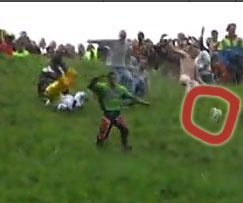
Momentum
The annual Gloucestershire Cheese Rolling.

Position
It is easy to write down the expectation value of the position of a particle in QM, but a little tricky to think about what it means...
$$\langle x \rangle = \int_{-\infty}^{+\infty} x|\Psi(x,t)|^2\,dx =\int_{-\infty}^{+\infty} \Psi^*\,x\Psi\,dx.$$
[BTW, I'm dropping the limits from the integrals for simplicity of writing, but remember they're there...]
- Humour me for arranging the pieces this way in the last term. (Since multiplication is commutative, I can put $x$ anywhere in the product...)
- We're using the $\langle ... \rangle$ brackets that indicate an average.
- But in QM, once we've measured a particle's position, its wave function collapses, and we don't have the original $\Psi$ anymore! So $\langle x \rangle$ can't be the average of many measurements on the same system.
- Instead, think of preparing many systems in the the exact same way, and then making just one measurement on each system. $\langle x \rangle$ is the average of those: a so-called ensemble average.
- We call this quantity the expectation value of $x$ (not the average).
That expectation value depends on time, so we could also calculate $$\frac{d\langle x \rangle}{dt}$$ How to think about it?
We can calculate it using the result derived in 5.3 "Normalizaton" $$\begineq \frac{d\langle x \rangle}{dt} &= \frac{d}{dt}\int x\Psi^*\Psi\,dx \\ &=\int x \frac{\del}{\del t}(\Psi^*\Psi)\,dx \\ "\langle v\rangle"&=\frac{i\hbar}{2m}\int x \frac{\del}{\del x}\left[ \Psi^*\frac{\del \Psi}{\del x} - \Psi\frac{\del \Psi^*}{\del x} \right]\,dx.\endeq$$
Interlude on integration by parts
Wouldn't you agree that: $$\begineq \frac{d}{dx}\left(xf(x)\right)&=f(x)+x\frac{d}{dx}f(x)\\ \int_a^b \frac{d}{dx}\left(xf(x)\right)\,dx&=\int_a^b\left(f(x)+x\frac{d}{dx}f(x)\right)\,dx\\ \left[xf(x)\right]_{a}^{x=b} &=\int_a^bf(x)\,dx+ \int_a^b x\frac{d}{dx}f(x)\,dx?\\ \endeq$$ Re-arranging this just a little... $$\int_a^b x\frac{d}{dx}f(x)\,dx = -\int_a^bf(x)\,dx +\left[xf(x)\right]_{a}^{b}.$$
The integral can be written in the form $\int fg'\,dx$ where $f(x)=x$ and $g(x)=\left[...\right]$. So, now we can apply integration by parts...: $$\begineq \int x \times \frac{\del}{\del x}\left[ \Psi^*\frac{\del \Psi}{\del x} - \Psi\frac{\del \Psi^*}{\del x} \right]\,dx &= -\int 1 \times \left[ \Psi^*\frac{\del \Psi}{\del x} - \Psi\frac{\del \Psi^*}{\del x} \right] \,dx \\ & \ \ \ \ \ \ \ + \left(x\times\left[ \Psi^*\frac{\del \Psi}{\del x} - \Psi\frac{\del \Psi^*}{\del x} \right] \right)_{-\infty}^{+\infty}\\ &= -\int \left[ \Psi^*\frac{\del \Psi}{\del x} - \Psi\frac{\del \Psi^*}{\del x} \right] \,dx \\ &= -2\int \Psi^*\frac{\del \Psi}{\del x} \,dx . \endeq$$
In the last step I used integration by parts again, this time on $\int \Psi\frac{\del \Psi^*}{\del x}\,dx$ with $f=\Psi$ and $g=\Psi^*$.
Should we believe that the expression $(...)_{-\infty}^{+\infty}$ vanishes?
It's a little stronger requirement on $\Psi$ this time, amounting to requiring that $|\Psi|$ drop off at least as fast as $1/x^\alpha$ (where $\alpha$ is some positive real number). as $x\to\pm\infty$...
Putting this result into our expression for the time rate of change of $\langle x \rangle$: $$\begineq \frac{d\langle x \rangle}{dt} &= -\frac{i\hbar}{m} \int \Psi^*\frac{\del \Psi}{\del x} \,dx = \int \Psi^*\left(\frac{\hbar}{im} \frac{\del}{\del x}\right)\Psi\,dx .\endeq $$
Multiplying $d\langle x\rangle /dt$ by $m$, we get something which we'll call $\langle p \rangle$. And now we can write the expectation values of position and momentum in parallel ways with "operators" sandwiched between $\Psi^*$ and $\Psi$ like this: $$\langle x \rangle=\int \Psi^* \hat{x}\Psi \,dx,$$ $$\langle p\rangle =\int \Psi^* \hat{p}\Psi \,dx,$$ where the operators are: $$\hat x \equiv x,$$ $$\hat p \equiv \frac{\hbar}{i}\frac{\del}{\del x}.$$
As it turns out, any quantity in classical mechanics can be expressed as a function of position and momentum. So, the recipe to get the expectation value of any function $Q(x,p)$ of classical position and momentum, is to sandwich $\hat Q$ written in terms of operators $\hat x$ and $\hat p$ between $\Psi^*$ and $\Psi$, and integrate.
$$\langle Q(x,p) \rangle = \int_{-\infty}^{+\infty} \Psi^*(x,t) \hat Q\left(\hat x,\hat p\right)\Psi(x,t)\,dx.$$
Consider the classical kinetic energy $T=\frac{1}{2}mv^2=\frac{1}{2m}p^2$. Using our new recipe: $$\begineq\langle T \rangle &= \int \Psi^*\,\frac{1}{2m}\left(\frac{\hbar}{i}\frac{\del}{\del x}\right)^2\Psi\,dx \\ &= \int \Psi^*\left(-\frac{\hbar^2}{2m}\right)\frac{\del^2\Psi}{\del x^2}\,dx.\endeq $$
Now, you should be able to see almost by inspection what you would get if you were to take $$\int \Psi^* [\text{r.h.s. of Sch equation}]\,dx=?$$
The uncertainty principle
Bring a spring to demo this in class.
...is related to properties of waves (Fig 1.7 in Griffiths).
- A wave train has a well defined wavelength, $\lambda$, but an ill-defined position.
- A single pulse has a well defined position, but an ill-defined wavelength.
Since de Broglie showed$$p=\frac{h}{\lambda},$$ This means that if you spread out the wavelengths, the momentum will also spread out. So perhaps the uncertainty principle which I state without proof looks at least plausible:
$$\sigma_x \sigma_p \geq \frac{\hbar}{2}.$$
$\sigma_x$ is a measure of the spread of the expected position, and $\sigma_p$ is a measure of the spread of expected momentum.
In the problems you'll do, you'll frequently verify that this inequality is not violated. But something closer to a proof of the relationship will not come until later.
...More about $\sigma$ from our spreadsheet exercises.